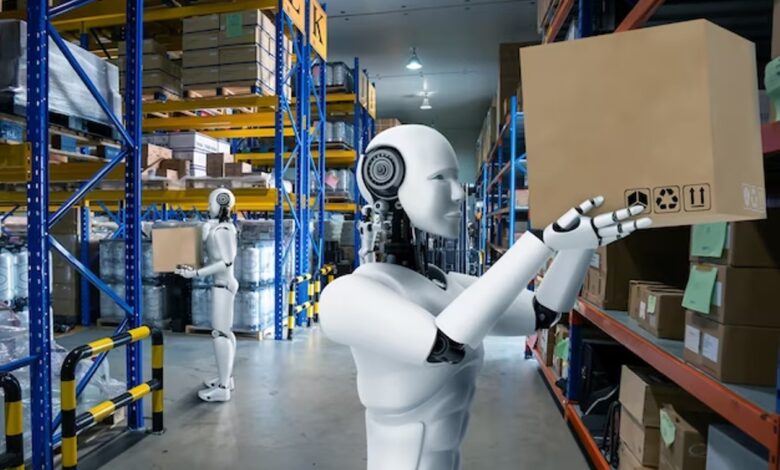How Automation is Changing the Warehousing Game in 2024

In today’s fast-paced world, businesses are constantly seeking ways to streamline operations, increase efficiency, and reduce costs. One sector that has seen a significant transformation in recent years is warehousing, thanks to automation. This article will explore how automation is reshaping the warehousing industry, with a focus on the evolving technologies, their benefits, and the challenges they present.
The Evolution of Warehousing
Warehousing has come a long way from traditional manual processes to highly automated and sophisticated systems. In the past, warehouses heavily relied on human labor for tasks like order picking, sorting, and inventory management. However, the need for speed and accuracy in the supply chain has pushed the industry to adopt automation.
Automation in Warehousing: A Brief Overview
Automation in warehousing involves the use of various technologies and systems to perform tasks that were once manually intensive. These technologies include robotics, artificial intelligence, and data analytics. They work together to optimize processes, reduce errors, and enhance the overall efficiency of warehouses.
Benefits of Automation in Warehousing
Enhanced Efficiency
Automation minimizes the time needed to complete tasks, increasing the speed and efficiency of order fulfillment and inventory management.
Error Reduction
The precision of automation technologies significantly reduces human errors, resulting in more accurate order processing.
Cost Savings
While the initial investment in automation can be substantial, it often results in long-term cost savings through reduced labor expenses and lower error-related costs.
Read More: The Future of the Automotive Industry
Types of Automation Technologies
Robotics and Drones
Robotic systems and drones play a vital role in automating various warehousing functions. They can perform tasks such as picking, packing, and even assisting with inventory management.
Warehouse Management Systems (WMS)
WMS software optimizes the allocation of resources, inventory tracking, and order processing, allowing for more efficient operations.
Automated Guided Vehicles (AGVs)
AGVs are autonomous vehicles that move goods within the warehouse, reducing the need for manual labor in material handling.
Automation and Inventory Management
Automation offers real-time visibility into inventory levels, making it easier to manage stock, reduce carrying costs, and avoid overstock or stockouts.
The Impact of Automation on Labor
While automation brings numerous benefits, it does have an impact on the workforce. Jobs that were once manual are now handled by machines, prompting a shift in the skills needed for the industry.
Challenges and Concerns
Initial Costs
Automation in Warehousing: The implementation of automation systems can be expensive, posing a barrier to entry for smaller businesses.
Security and Data Privacy
With automation comes the need for robust cybersecurity measures to protect sensitive data.
Adaptation and Training
Automation in Warehousing: Workers must adapt to new technologies, requiring time and resources for training.
Case Studies: Successful Automation Implementation
Amazon’s Robotic Warehouses
Automation in Warehousing: Amazon’s extensive use of robots in its fulfillment centers has enabled faster order processing and improved customer service.
Alibaba’s Smart Warehouse
Alibaba has implemented an innovative “Smart Warehouse” concept, combining automation and AI to enhance efficiency and reduce costs.
Future Trends in Warehousing Automation
Automation in Warehousing: The warehousing industry is on the cusp of significant transformations, driven by advancements in technology and changing market dynamics. These future trends in warehousing automation are set to shape the way goods are stored, managed, and distributed:
AI and Machine Learning Integration
Artificial Intelligence (AI) and Machine Learning (ML) are poised to revolutionize warehousing. With AI, warehouses can process and analyze vast amounts of data in real-time. This will lead to smarter inventory management, predictive analytics, and efficient order processing. Machines will learn from historical data, making better decisions to optimize warehouse operations. As AI and ML become more accessible, even smaller warehouses will benefit from these insights.
Sustainability and Environmental Considerations
Automation in Warehousing: Environmental sustainability is a growing concern across industries. Warehousing is no exception. Future warehouses will incorporate green practices, including energy-efficient lighting, heating, and cooling systems. Automation will play a role in minimizing energy consumption by optimizing processes and reducing waste. The “green” warehouse of the future will be both cost-effective and eco-friendly.
IoT-Enabled Warehouses
The Internet of Things (IoT) is already transforming warehousing, but its potential is far from fully realized. In the future, more devices and equipment within warehouses will be connected through IoT. This connectivity will allow for real-time monitoring of equipment and inventory, reducing downtime and streamlining maintenance. IoT will also enable predictive maintenance, addressing issues before they lead to costly breakdowns.
Robotic Collaboration with Humans
Automation in Warehousing: While robots are becoming more prevalent in warehouses, they will increasingly collaborate with human workers. Robots will handle repetitive and physically demanding tasks, allowing humans to focus on tasks that require creativity, decision-making, and complex problem-solving. This collaboration will make warehouses more efficient while preserving the human touch where it matters.
Blockchain for Transparency
Blockchain technology, known for its transparency and security, will find applications in warehousing. It will be used to create an unchangeable and transparent ledger of transactions and movements within the supply chain. This will enhance trust and traceability, reducing errors, fraud, and disputes.
Voice and Augmented Reality (AR) Technologies
Automation in Warehousing: Voice technology and AR will be integrated into warehouse operations. Voice commands will guide workers to pick and pack items more efficiently. AR will provide workers with real-time information and instructions, reducing the need for extensive training and improving accuracy.
Customized Automation Solutions
As technology becomes more accessible and adaptable, warehouses will increasingly opt for customized automation solutions. These systems will be tailored to the unique needs of specific warehouses, optimizing processes and reducing costs. This trend will democratize automation, making it accessible to a broader range of businesses.
Enhanced Security Measures
Automation in Warehousing: With the increasing amount of valuable data stored and processed in automated warehouses, security will be a top priority. Warehouses will invest in advanced cybersecurity measures, including biometric access control and data encryption, to protect sensitive information.
Read More: Automotive Safety: A Comprehensive Guide
Conclusion: Changing the Warehousing
The impact of automation on the warehousing industry is profound, reshaping the way we manage and operate warehouses. As we’ve explored, automation brings a myriad of benefits, including enhanced efficiency, reduced errors, and cost savings. Various technologies, such as robotics, AI, and data analytics, have played a pivotal role in this transformation.
However, it’s essential to acknowledge the challenges that come with automation, such as initial costs, security concerns, and the need for workforce adaptation. Overcoming these challenges requires strategic planning and investment.
We’ve also delved into successful case studies, like Amazon’s robotic warehouses and Alibaba’s Smart Warehouse, which demonstrate how automation can be effectively implemented in large-scale operations.
FAQs
1. Is automation only suitable for large warehouses?
Automation can be tailored to suit warehouses of various sizes, but the initial costs may be a limiting factor for smaller operations.
2. Are there risks of job displacement due to automation in warehousing?
While some jobs may be automated, there will still be a need for skilled technicians to maintain and oversee automation systems.
3. How do businesses ensure the security of data in automated warehouses?
Robust cybersecurity measures, such as firewalls and encryption, are essential for protecting data in automated warehouses.
4. What role will human workers play in automated warehouses?
Human workers will still be needed for tasks that require decision-making, creativity, and complex problem-solving.
5. How can businesses prepare for the future of warehousing automation?
Businesses should invest in workforce training, stay updated on industry trends, and consider the long-term benefits of automation.












One Comment